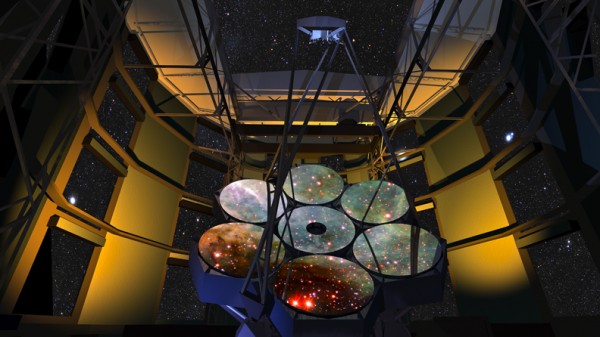 Later this month at the University of Arizona’s Steward Observatory Mirror Lab, the third, of 7 mirrors for the Giant Magellan Telescope (GMT) will be cast inside a rotating furnace at the facility. To mark the milestone, on Saturday, August 24, 2013, the Mirror Lab will host a rare media opportunity to witness this milestone in the creation of the optics for the GMT.
Later this month at the University of Arizona’s Steward Observatory Mirror Lab, the third, of 7 mirrors for the Giant Magellan Telescope (GMT) will be cast inside a rotating furnace at the facility. To mark the milestone, on Saturday, August 24, 2013, the Mirror Lab will host a rare media opportunity to witness this milestone in the creation of the optics for the GMT.
When complete, the Giant Magellan Telescope will be much larger than any telescope currently in operation and will take images with 10 times the resolution of the Hubble Space Telescope. With seven 28 foot diameter mirrors, GMT will have the viewing power of a mirror about 80 feet across.
An immense leap forward over the capabilities of current telescopes, the Giant Magellan Telescope’s extreme sensitivity and resolution will streamline research on the mysteries of black holes, dark matter, dark energy and the accelerating expansion of the universe.
Additionally, the GMT will add to the recent discoveries of planets beyond our solar system by being able to directly image these planets around other stars. Its increased resolution may help astronomers verify the existence of conditions conducive to life elsewhere in the universe.
In the video below, the process of making each of the 20 ton mirrors for the Giant Magellan Telescope is described in more detail. But in order to get the detailed resolution desires for the GMT, each mirror’s surface must be smooth to within a twentieth of a wavelength of light, or one millionth of an inch.
The Mirror Lab is inviting the media to participate in all events on August 24th, including a tour of the Mirror Lab by senior staff where they will witness the liquid glass as it is spun cast in the rotating furnace at a temperature of 1170 degrees C (2140 F), and observe the mirror polishing procedure. For more information on the GMT, visit www.gmto.org
![Herbal Reference Substances are Key to Everyday Products <!-- AddThis Sharing Buttons above -->
<div class="addthis_toolbox addthis_default_style " addthis:url='http://newstaar.com/herbal-reference-substances-are-key-to-everyday-products/3512112/' >
<a class="addthis_button_facebook_like" fb:like:layout="button_count"></a>
<a class="addthis_button_tweet"></a>
<a class="addthis_button_pinterest_pinit"></a>
<a class="addthis_counter addthis_pill_style"></a>
</div>When it comes to quality control testing and the development of new products, Botanical Reference Materials (BRMs), also known as Herbal References are critically important. To help companies ultimately obtain all-important FDA approval, the Food and Drug Administration provides in its guidance a recommendation that […]<!-- AddThis Sharing Buttons below -->
<div class="addthis_toolbox addthis_default_style addthis_32x32_style" addthis:url='http://newstaar.com/herbal-reference-substances-are-key-to-everyday-products/3512112/' >
<a class="addthis_button_preferred_1"></a>
<a class="addthis_button_preferred_2"></a>
<a class="addthis_button_preferred_3"></a>
<a class="addthis_button_preferred_4"></a>
<a class="addthis_button_compact"></a>
<a class="addthis_counter addthis_bubble_style"></a>
</div>](http://newstaar.com/wp-content/uploads/2021/02/Achillea_millefolium_flowers-100x100.jpg)
![Quality Electrochemical Biosensors are Critical for Medical, Food and Chemical Industry <!-- AddThis Sharing Buttons above -->
<div class="addthis_toolbox addthis_default_style " addthis:url='http://newstaar.com/quality-electrochemical-biosensors-are-critical-for-medical-food-and-chemical-industry/3512086/' >
<a class="addthis_button_facebook_like" fb:like:layout="button_count"></a>
<a class="addthis_button_tweet"></a>
<a class="addthis_button_pinterest_pinit"></a>
<a class="addthis_counter addthis_pill_style"></a>
</div>A number of industries have, at their core, a need to frequent or even continuous analysis of biological media. These include the medical and pharmaceutical fields, biotech firms, and food and chemical companies. To maintain quality standards and develop new products, these industries rely heavily […]<!-- AddThis Sharing Buttons below -->
<div class="addthis_toolbox addthis_default_style addthis_32x32_style" addthis:url='http://newstaar.com/quality-electrochemical-biosensors-are-critical-for-medical-food-and-chemical-industry/3512086/' >
<a class="addthis_button_preferred_1"></a>
<a class="addthis_button_preferred_2"></a>
<a class="addthis_button_preferred_3"></a>
<a class="addthis_button_preferred_4"></a>
<a class="addthis_button_compact"></a>
<a class="addthis_counter addthis_bubble_style"></a>
</div>](http://newstaar.com/wp-content/uploads/2020/10/Electrochemical-Biosensor-100x100.jpg)
![Company Develops Industrial Mixers Well-Suited for both Fragile and Explosive Products <!-- AddThis Sharing Buttons above -->
<div class="addthis_toolbox addthis_default_style " addthis:url='http://newstaar.com/company-develops-industrial-mixers-well-suited-for-both-fragile-and-explosive-products/3512071/' >
<a class="addthis_button_facebook_like" fb:like:layout="button_count"></a>
<a class="addthis_button_tweet"></a>
<a class="addthis_button_pinterest_pinit"></a>
<a class="addthis_counter addthis_pill_style"></a>
</div>Industrial drum mixers are normally applied to blend mixes of varying viscosities such as adhesive slurries or cement. Some of these mixers have the capability of blending mixes of very different particle sizes such as fruit and ice cream, and gravel and cement slurry. The […]<!-- AddThis Sharing Buttons below -->
<div class="addthis_toolbox addthis_default_style addthis_32x32_style" addthis:url='http://newstaar.com/company-develops-industrial-mixers-well-suited-for-both-fragile-and-explosive-products/3512071/' >
<a class="addthis_button_preferred_1"></a>
<a class="addthis_button_preferred_2"></a>
<a class="addthis_button_preferred_3"></a>
<a class="addthis_button_preferred_4"></a>
<a class="addthis_button_compact"></a>
<a class="addthis_counter addthis_bubble_style"></a>
</div>](http://newstaar.com/wp-content/uploads/2020/06/bandeau-sofragir2-100x100.jpg)